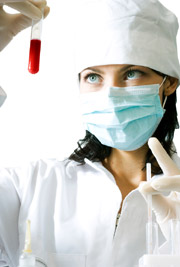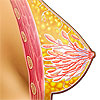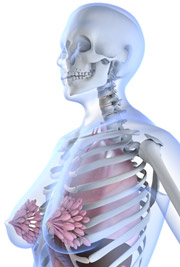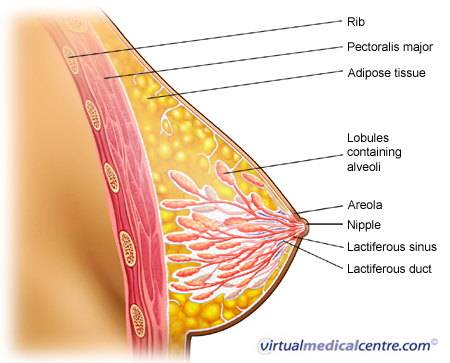- What is nipple discharge?
- What causes nipple discharge?
- Seeing a doctor for nipple discharge
- Innocent versus cancerous nipple discharge
Investigating the cause of nipple discharge
- Treatments for nipple discharge
- Nipple discharge in males
What is nipple discharge?
Nipple discharge is defined as any leakage of fluid from the breast. It is one of the most commonly encountered breast-related symptoms. It can account for up to 7% of all breast symptoms and may be due to innocent (benign) causes or an underlying cancer (malignant cause). In general, nipple discharge is mostly due to innocent causes. National guidelines and research show that there is an underlying cancer in 1–9% of all nipple discharge cases, depending on the individual’s age and the characteristics of the discharge.
Information on re-publishing of our images
What causes nipple discharge?
Physiological causes
Physiological discharge refers to nipple discharge which occurs as a result of natural processes occurring in the body. Lactation (the production of breastmilk), which occurs during pregnancy and after childbirth, is one of the causes of nipple discharge. The mammary glands of the breasts produce milk and colostrum in response to various hormonal changes which arise as a result of pregnancy. Physiological nipple discharge may also occur due to hormonal influences outside of pregnancy, especially in women of reproductive age.
Benign causes
Benign diseases that may cause nipple discharge include:
- Intraductal papillomas (non-cancerous tumours of the milk duct in the breast);
- Chronic mastitis (chronic inflammation of the breast);
- Fibrocystic changes (non-cancerous tumours of the breast due to hormonal changes);
- Mammary duct ectasia (enlargement of milk ducts in the breast);
- Fibroadenoma (non-cancerous tumour of the breast);
- Ductal hyperplasia (normal thickening of the lining of the milk ducts of the breast); and
- Nipple adenoma (non-cancerous tumour of the nipple).
Of these conditions, abnormal nipple discharges are most commonly caused by mammary duct ectasia.
Other causes of nipple discharge include the use of medications such as metoclopramide and domperidone, which are often used as anti-nausea drugs.
Malignant causes
The pre-cancerous or cancerous diseases that may cause nipple discharge include:
- Atypical ductal hyperplasia (abnormal thickening of the lining of the milk ducts);
- Ductal carcinoma in-situ (localised cancerous breast tumour);
- Lobular carcinoma in-situ (localised cancerous breast tumour);
- Invasive ductal carcinoma (widespread cancerous breast tumour);
- Invasive lobular carcinoma(widespread cancerous breast tumour); and
- Paget’s disease of the nipple (cancer of the breast spread through the skin into the nipple).
Table 1: Summary of causes of nipple discharge
| Female reproductive health | General medical conditions | |
|---|---|---|
|
Benign |
Malignant |
|
|
|
|
Seeing a doctor for nipple discharge

Key features and characteristics of the nipple discharge may be determined in both the clinical history and examination. Of particular importance are the:
- Nipple discharge colour (clear, bloody, white, green/yellow);
- Spontaneity (expressed versus spontaneous);
- Unilateral versus bilateral (from one breast versus from both breasts); and
- Single versus multiple milk ducts.
A summary of these features is presented below.
Questions your doctor might ask (clinical history)
Your doctor may ask questions to determine your risk factors for breast cancer, medication use, recent history of trauma, and menstrual history. In addition, they will rule out the presence of other breast symptoms such as skin redness, pain or a lump. Other details that may be explored during history taking include previous results of mammograms.
Examining your breast and nipple
A complete breast examination includes all four quadrants of the breast and an examination of the lymph nodes under the arm.
The aim of the examination is to:
- Detect any skin changes;
- Feel for enlarged lymph nodes under the arm or at the collarbone;
- Feel for breast lumps;
- Identify areas which are sore; and
- Express discharge from a nipple and thus identify the involved ducts.
Innocent versus cancerous nipple discharge
The main characteristics of an innocent nipple discharge are that it is usually bilateral (occurring in both breasts) and present only on expression. There are also no signs of obvious lumps or presence of blood on clinical examination.
On the other hand, nipple discharge caused by cancer tends to occur spontaneously, only on one side, and is often from a single duct. The discharge is usually clear, compared to other colours such as milky or green.
The most common causes of bloody nipple discharge are benign. However, as blood discharge can also be caused by a breast cancer, it is always safest to investigate this symptom further.
Table 2: Summary of benign versus malignant nipple discharge characteristics
| Characteristic | Benign / non-suspicious | Malignant / suspicious |
|---|---|---|
| Spontaneity of nipple discharge | Non-spontaneous / requires expression | Spontaneous |
| Colour of nipple discharge | Milky, green, yellow, bloody or multi-coloured | Clear, yellow (serous), pink (serosanguineous), bloody |
| Unilateral / bilateral discharge | Bilateral | Unilateral |
| Presence of palpable breast mass or other breast symptoms | Not present | Present |
| Number of ducts | Multiple ducts | Single duct |
| Consistency of discharge | Sticky | Clear |
Investigating the cause of nipple discharge
Laboratory tests

Prolactin is a hormone produced in the body that controls breastmilk production. Serum prolactin levels are generally tested to exclude a prolactin-secreting brain tumour which can lead to milk discharge from the breast. The levels of prolactin are measured through obtaining a small sample of blood.
Thyroid-stimulating hormone (TSH) is a hormone produced by the pituitary gland in the brain which regulates thyroid function. TSH levels are obtained to rule out hypothyroidism, which may present with nipple discharge. The levels of TSH are measured through obtaining a small sample of blood.
A pregnancy test (urine or blood bhCG levels) may be indicated to rule out temporary nipple discharge associated with pregnancy. Beta human chorionic gonadotropin (bhCG) is a hormone produced by the placenta during pregnancy.
All the endocrinological tests are generally not required for the evaluation of suspicious discharges.
Discharge cytology
Discharge cytology is a test whereby the cells present in the nipple discharge are studied under a microscope. This test is rarely done because it has not been shown to be useful in determining the cause of the nipple discharge.
Skin punch biopsy
A skin punch biopsy is a test whereby a small sample of skin is removed and sent to the pathologist to be studied under the microscope. It is usually only used to determine the cause of nipple discharge if Paget’s disease of the breast is suspected. Paget’s disease of the breast is a condition which occurs as a result of breast cancer spreading to the external skin surface. The main symptoms of Paget’s disease are skin changes similar to atopic dermatitis (eczema) that may be associated with a clear yellowish discharge. A diagnosis of breast cancer can be made with a punch biopsy of the nipple. Paget’s disease of the breast is ruled out with a punch biopsy before a diagnosis of nipple eczema is made.
Imaging tests
Mammography
A mammogram is an x-ray of both breasts. It is often the first imaging test used to reveal an underlying abnormality in the breast. Features that are looked for in a mammogram include the presence of a lump, deposits of calcium, abnormal tissue changes and asymmetry.
Individuals above the age of 35 with suspicious nipple discharge are often offered mammography.
Mammography is very useful for detecting cancer and has a very low false positive rate. However, mammography is less useful in younger women as the breast tissue is more dense and thus ultrasound is usually preferred.
Ultrasound
Ultrasonography is another imaging test useful for diagnosing diseases of the milk ducts. It can be used to distinguish between solid lumps and fluid-filled sacs. It also allows for accurate sampling of the underlying abnormality and helps locate the abnormality during surgery. Ultrasound may be used to visualise breast abnormalities in younger women who have denser breast tissue.
Ductography
Ductography is a technically challenging investigation primarily used for suspicious nipple discharges. A radiologist inserts a needle into the discharging duct. Iodine-containing contrast medium (a substance that allows increased contrast between structures on medical imaging) is then injected and an x-ray is taken.
The test is abnormal if there is a filling defect of the milk ducts, obstruction of the milk ducts, or abnormality of the milk duct walls. Ductography helps to localise the exact position of the underlying abnormality, thus increasing the success rates of a diagnostic major duct excision.
Magnetic resonance imaging
Breast MRI is very useful for detecting widespread disease and is an effective diagnostic imaging test for identifying cancers that cannot be detected clinically or by mammography. However, due to a high false positive rate, breast MRI is still less useful than mammography.
Treatments for nipple discharge

If your doctor has not found any abnormality on both clinical examination and imaging, close observation is an option for people who wish to avoid surgical treatment. However, clinical follow-up is advised in 2–3 months for spontaneous discharges where clinical and imaging evaluation are negative. It is also advisable to continue with routine screening. Mammography is recommended to screen for breast cancer once every two years for women aged between 50 and 69.
Surgical treatments
Major duct excision can be offered to everyone who has suspicious discharge and to those who suffer from benign discharge that is persistent and bothersome. This would definitely rule out the presence of a cancer and cause the discharge to stop.
Major duct excision is usually performed under local anaesthetic as an outpatient procedure. The affected duct may be identified before the operation via ductography. The surgeon would usually make a cut around the nipple. The surgeon would then remove most of the tissue at least 2–3 cm back from the nipple. Major duct excision involves removal of all or most of the subareolar (area deep to the nipple) ductal tissue.
Complications and contraindications of surgery
There are relatively few complications associated with major duct excision. Surgical risks (such as allergies to the anaesthetic used, bleeding, damage to surrounding structures, and infections) are rare.
Depending on the extent of the excision, duct excision can decrease nipple sensation and hamper the ability to breastfeed. If you intend to breastfeed in the future, you must discuss this with your doctor.
Disruption of the nerve supply to the nipple is another complication which may cause numbness and nipple retraction. Cauterising the undersurface of the nipple during surgery may also result in nipple necrosis (death of tissue, usually due to disruption of blood supply).
Nipple discharge in males
Male breast cancer is very rare and makes up less than 1% of all breast cancers. The most common symptoms in men are a breast lump, followed by breast tenderness and nipple discharge. Diagnosing and treating breast cancer is similar in both men and women.
However, in comparison to female breast cancer, nipple discharge in men is caused by cancer in 75% of cases. Therefore it is essential that a man experiencing any nipple discharge speaks to his doctor as soon as possible for testing.
More information
 |
For more information on breast cancer, types of breast cancer and its investigations and treatments, as well as some useful videos, see Breast Cancer. |
References
- Gioffrè Florio M, Manganaro T, Pollicino A, et al. Surgical approach to nipple discharge: A ten-year experience. J Surg Oncol. 1999;71(4):235-8. [Abstract]
- IBS: The investigation of a new breast symptom: Guide for GPs [online]. Strawberry Hills, NSW: National Breast and Ovarian Cancer Centre; 1 February 2006 [cited 15 March 2011] Available from: URL link
- King TA, Carter KM, Bolton JS, Fuhrman GM. A simple approach to nipple discharge. Am Surg. 2000;66(10):960-5. [Abstract]
- Neville MC, McFadden TB, Forsyth I. Hormonal regulation of mammary differentiation and milk secretion. J Mammary Gland Biol Neoplasia. 2002;7(1):49-66. [Abstract]
- Brennan M, Houssami N, French J. Management of benign breast conditions. Part 3: Other breast problems. Aust Fam Physician. 2005;34(5):353-5. [Abstract | Full text]
- Lee WY. Cytology of abnormal nipple discharge: A cyto-histological correlation. Cytopathology. 2003;14(1):19-26. [Abstract]
- Longmore M, Wilkinson I, Rajagopalan SR. Oxford Handbook of Clinical Medicine (6th edition). Oxford: Oxford University Press; 2004. [Book]
- Talley NJ, O’Connor S. Clinical Examination: A systematic guide to physical diagnosis (4th edition). Eastgardens, NSW: MacLennan & Petty; 2001. [Book]
- Leis HP Jr. Management of nipple discharge. World J Surg. 1989;13(6):736-42. [Abstract]
- Simmons R, Adamovich T, Brennan M, et al. Nonsurgical evaluation of pathologic nipple discharge. Ann Surg Oncol. 2003;10(2):113-6. [Abstract]
- Lucarotti ME, Dunn JM, Webb AJ. Scrape cytology in the diagnosis of Paget’s disease of the breast. Cytopathology. 1994;5(5):301-5. [Abstract]
- Burkitt HG, Quick CRG, Reed JB. Essential Surgery: Problems, diagnosis and management (4th edition). Philadelphia, PA: Elsevier Saunders; 2007. [Book]
- Vargas HI, Vargas MP, Eldrageely K, et al. Outcomes of clinical and surgical assessment of women with pathological nipple discharge. Am Surg. 2006;72(2):124-8. [Abstract]
- Ballesio L, Maggi C, Savelli S, et al. Adjunctive diagnostic value of ultrasonography evaluation in patients with suspected ductal breast disease. Radiol Med. 2007;112(3):354-65. [Abstract]
- Cardenosa G, Doudna C, Eklund GW. Ductography of the breast: Technique and findings. Am J Roentgenol. 1994;162(5):1081-7. [Abstract | Full text]
- Morrogh M, Morris EA, Liberman L, et al. The predictive value of ductography and magnetic resonance imaging in the management of nipple discharge. Ann Surg Oncol. 2007;14(12):3369-77. [Abstract]
- Kumar P, Clark M (eds). Clinical Medicine (5th edition). Edinburgh: WB Saunders Company; 2002. [Book]
- Hill TD, Khamis HJ, Tyczynski JE, Berkel HJ. Comparison of male and female breast cancer incidence trends, tumor characteristics, and survival. Ann Epidemiol. 2005;15(10):773-80. [Abstract]
- Lanitis S, Rice AJ, Vaughan A, et al. Diagnosis and management of male breast cancer. World J Surg. 2008;32(11):2471-76. [Abstract]
- Jatoi I, Kaufmann M (eds). Management of Breast Diseases (1st edition). New York, NY: Springer-Verlag Berlin Heidelberg; 2010. [Book]
Diseases and conditions associated with nipple discharge include:
- Atopic Dermatitis (Eczema)
- Breast Cancer (Pre-Invasive Ductal Carcinoma; Ductal Carcinoma In Situ; DCIS)
- Breast Cancer (Pre-Invasive Lobular Carcinoma; Lobular Carcinoma In Situ; LCIS)
- Hyperprolactinaemia
- Hypothyroidism
- Male Breast Cancer (Male Breast Carcinoma)
- Pituitary Gland Cancer (Carcinoma of the Pituitary gland)
All content and media on the HealthEngine Blog is created and published online for informational purposes only. It is not intended to be a substitute for professional medical advice and should not be relied on as health or personal advice. Always seek the guidance of your doctor or other qualified health professional with any questions you may have regarding your health or a medical condition. Never disregard the advice of a medical professional, or delay in seeking it because of something you have read on this Website. If you think you may have a medical emergency, call your doctor, go to the nearest hospital emergency department, or call the emergency services immediately.









